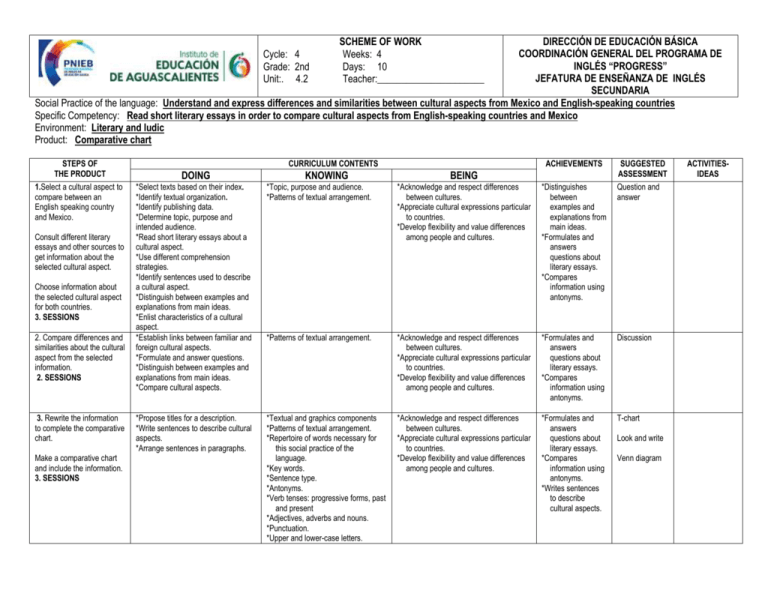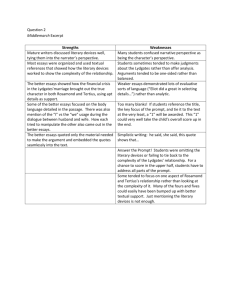2nd Grade. Unit 4. Part 2
advertisement

DIRECCIÓN DE EDUCACIÓN BÁSICA COORDINACIÓN GENERAL DEL PROGRAMA DE INGLÉS “PROGRESS” JEFATURA DE ENSEÑANZA DE INGLÉS SECUNDARIA Social Practice of the language: Understand and express differences and similarities between cultural aspects from Mexico and English-speaking countries Specific Competency: Read short literary essays in order to compare cultural aspects from English-speaking countries and Mexico Environment: Literary and ludic Product: Comparative chart Cycle: 4 Grade: 2nd Unit:. 4.2 STEPS OF THE PRODUCT 1.Select a cultural aspect to compare between an English speaking country and Mexico. Consult different literary essays and other sources to get information about the selected cultural aspect. Choose information about the selected cultural aspect for both countries. 3. SESSIONS 2. Compare differences and similarities about the cultural aspect from the selected information. 2. SESSIONS 3. Rewrite the information to complete the comparative chart. Make a comparative chart and include the information. 3. SESSIONS SCHEME OF WORK Weeks: 4 Days: 10 Teacher:______________________ CURRICULUM CONTENTS DOING KNOWING ACHIEVEMENTS BEING SUGGESTED ASSESSMENT *Select texts based on their index. *Identify textual organization. *Identify publishing data. *Determine topic, purpose and intended audience. *Read short literary essays about a cultural aspect. *Use different comprehension strategies. *Identify sentences used to describe a cultural aspect. *Distinguish between examples and explanations from main ideas. *Enlist characteristics of a cultural aspect. *Establish links between familiar and foreign cultural aspects. *Formulate and answer questions. *Distinguish between examples and explanations from main ideas. *Compare cultural aspects. *Topic, purpose and audience. *Patterns of textual arrangement. *Acknowledge and respect differences between cultures. *Appreciate cultural expressions particular to countries. *Develop flexibility and value differences among people and cultures. *Distinguishes between examples and explanations from main ideas. *Formulates and answers questions about literary essays. *Compares information using antonyms. Question and answer *Patterns of textual arrangement. *Acknowledge and respect differences between cultures. *Appreciate cultural expressions particular to countries. *Develop flexibility and value differences among people and cultures. *Formulates and answers questions about literary essays. *Compares information using antonyms. Discussion *Propose titles for a description. *Write sentences to describe cultural aspects. *Arrange sentences in paragraphs. *Textual and graphics components *Patterns of textual arrangement. *Repertoire of words necessary for this social practice of the language. *Key words. *Sentence type. *Antonyms. *Verb tenses: progressive forms, past and present *Adjectives, adverbs and nouns. *Punctuation. *Upper and lower-case letters. *Acknowledge and respect differences between cultures. *Appreciate cultural expressions particular to countries. *Develop flexibility and value differences among people and cultures. *Formulates and answers questions about literary essays. *Compares information using antonyms. *Writes sentences to describe cultural aspects. T-chart Look and write Venn diagram ACTIVITIESIDEAS 4. Check that writing is complete and complies with grammar, spelling, and punctuation conventions. Display the comparative chart in an exhibition. 2. SESSIONS *Identify sentences used to describe a cultural aspect. *Identify textual organization. *Textual and graphics components *Acoustic features. *Repertoire of words necessary for this social practice of the language. *Sentence type. *Antonyms. *Verb tenses: progressive forms, past and present *Adjectives, adverbs and nouns. *Punctuation. *Homophones *Upper and lower-case letters. *Acknowledge and respect differences between cultures. *Appreciate cultural expressions particular to countries. *Develop flexibility and value differences among people and cultures. *Writes sentences to describe cultural aspects Rubrics (checking writing complies with grammar, spelling and punctuation conventions) Oral presentation









